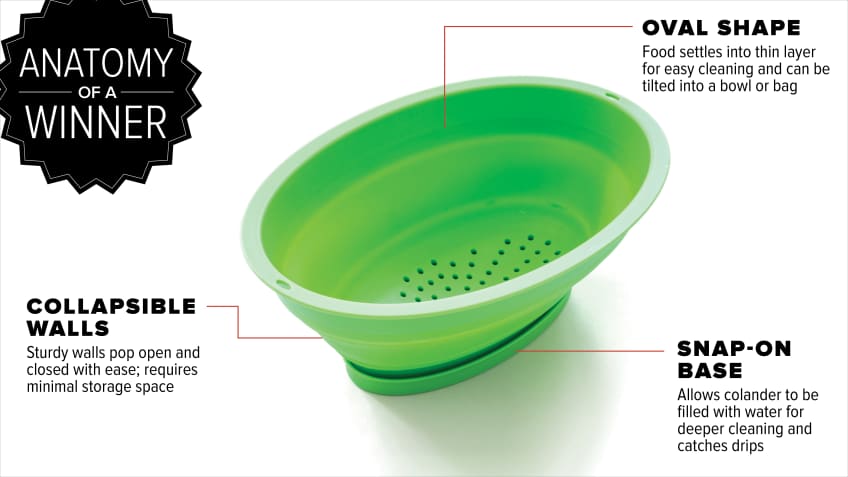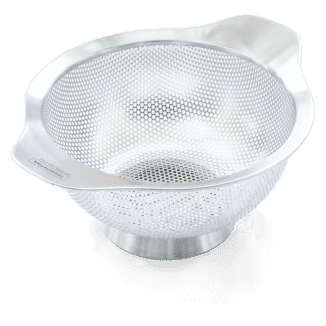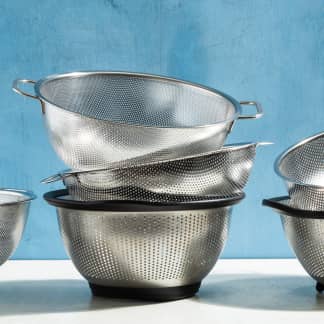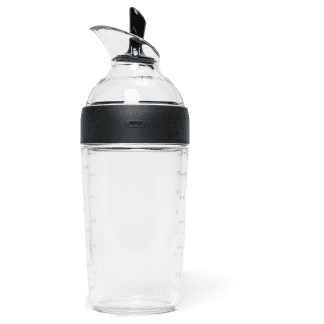When we need to clean a pint of cherry tomatoes or rinse a can of beans, our favorite 5-quart stainless-steel colander, which is about 11 inches wide and more than 5 inches tall, feels oversize. For these sorts of small tasks, we reach for the Progressive Prepworks Collapsible Mini Colander, our longtime favorite mini colander. We like that this tool, unlike our favorite full-size colander, fits on the top rack of our dishwasher and collapses for compact storage. When we noticed that many other mini colanders are now on the market, we wondered which was best. We tested seven colanders, including our longtime favorite and two models sold as a set. All were priced from about $7 to roughly $19, and all had capacities from 2½ cups to 12 cups. In addition to collapsible colanders (all of which were made of flexible thermoplastic elastomer), we included models made from stainless steel, melamine, or plastic. We used each model to rinse 1 pound of strawberries (the amount in a rectangular plastic clamshell container) and to rinse and drain a 15.5-ounce can of chickpeas.
Two Ways To Use Mini Colanders
Most models were intended to be used exactly as you might imagine: You place food inside the colander and then hold it under running water, gently tilting or shaking the colander to make sure that all the contents are rinsed. Two of the models in our lineup could also be filled with water, which can be useful when cleaning especially delicate or dirty produce. One is equipped with a snap-on base that prevents water from draining out. The other model comes with a special plastic bowl into which you insert the colander before filling the bowl with water. The colander is suspended in the bowl by two small tabs positioned near the bowl’s handles. These tabs allow the bowl to be swung back and forth and keep the contents of the colander in place when pouring out the water.
The model with the snap-on base was simple and well designed. The base was sturdy, it popped on and off easily, and water drained quickly from the colander when it was removed. The other model, however, required more finesse. The colander swung on those narrow tabs like a passenger pod on a ferris wheel, so when we gripped the bowl’s handles and angled it forward in the sink to empty the water, the colander stayed upright, containing the contents. It was a clever idea, but it felt a little precarious.


A Good Mini Colander Is Small But Spacious
Next we turned our attention to the colanders’ other features. When we last reviewed large colanders, we found that the size and arrangement of the drainage holes were crucial. The best models contained plenty of small holes that not only allowed cooking water to drain away quickly before foods overcooked but also prevented tiny items such as angel hair pasta or orzo from escaping the bowl. However, with the smaller colanders, these two factors didn’t influence our preferences. Water flowed quickly through the holes of all the models, and their holes were small enough to contain all foods (even orzo). Instead, the size and shape of the colander itself proved pivotal to its success.

One model, with a capacity of 2½ cups, was simply too small. The chickpeas fit with no problem, but the strawberries were piled well above its rim. We had to hold the fruit in place with one hand while we rinsed it, which wasn’t very efficient. Models with capacities of at least 3 cups performed better, but not just because they were bigger: The shapes of their bowls also mattered. One collapsible model had a wide, square opening that narrowed considerably at the base, resembling an upside-down pyramid. It was difficult to agitate the chickpeas, and we couldn’t see the ones at the bottom of the colander, which made it hard to tell if we were successfully rinsing away the thick, starchy canning liquid. We liked models with broader bowls that allowed the chickpeas and strawberries to settle into a fairly thin layer, giving us the ability to gently shake the contents as needed to see if they were clean.
Are Collapsible Models Worthwhile?
Finally, we considered the benefits of the four collapsible models, all of which offered a real advantage in terms of storage, going from 2 1/2 inches to about 4 inches tall when expanded to just 1 to 1¼ inches tall when collapsed. They all worked similarly: The walls featured two pleats where the material doubled over on itself. It took several attempts to collapse the walls of the models in the two-piece set along their creases. When we took a closer look at these models, we noticed that only their top rims were reinforced with rigid plastic. Conversely, both the top and base rims of the other three models were reinforced with plastic, which made these models much sturdier; their walls snapped open with a reassuring pop and collapsed easily.

The Best Mini Colander: Progressive Prepworks Collapsible Mini Colander
When it was time to pack up the mini colanders at the end of testing, we were reluctant to part with our winner, the Progressive Prepworks Collapsible Mini Colander. Even though the capacity of our longtime favorite is just 3½ cups, we were able to arrange the strawberries and chickpeas in relatively shallow layers, which allowed us to clean them well. We loved its oval shape, which made it easy to funnel just-cleaned contents into a salad bowl or storage container. Its snap-on base increased its usefulness, letting us fill it with water when cleaning especially delicate or dirty produce. Another perk? It collapsed to a compact 1-inch-tall oval for easy storage. Plus, it’s durable—it showed no signs of wear or tear after we expanded and collapsed it 100 times and washed it repeatedly. We’re sure that it will become a much-used tool in any kitchen.
- Capacity of at least 3 cups
- Fairly wide, broad bowl that allows food to settle into a thin layer
- For collapsible models, sturdy walls reinforced with plastic at the top and bottom so that they expand and collapse easily
- For models with a snap-on base or an external bowl, bowls are easy to fill with water and then drain
- Dishwasher-safe
- Test seven models, priced from about $7 to about $19, including four collapsible models made from a flexible thermoplastic elastomer or rubber and three plastic, melamine, or stainless-steel models
- Drain and rinse a 15.5-ounce can of chickpeas
- Wash 1 pound of strawberries
- Wash by hand three times and in the dishwasher an additional 10 times
- Open and close collapsible models 100 times













